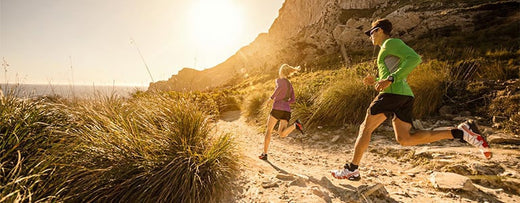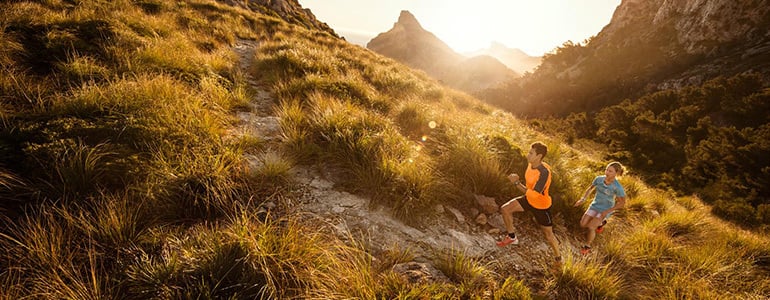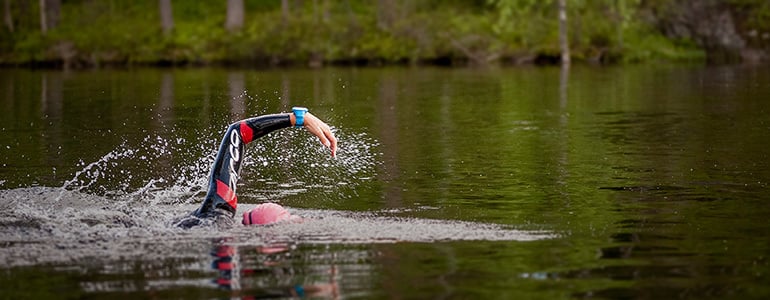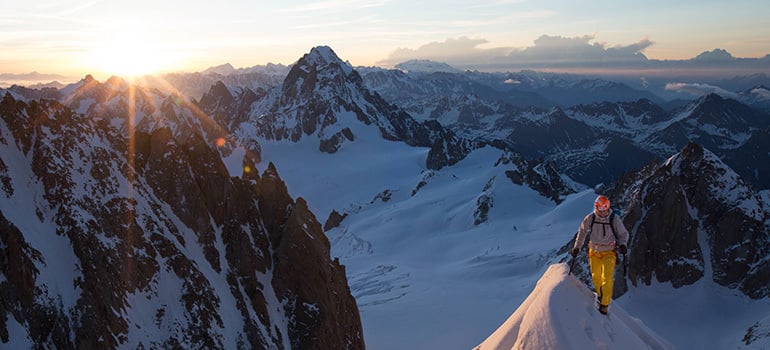

SUUNTOブログ

How do I run?
Want to become a stronger runner? Post a video of yourself running on Instagram to get some feedback from a professional running coach. Also read XTERRA world champion Josiah Middaugh’s running technique tips and drills. Read on to learn more!
We are happy to launch How do I run, a three-week campaign designated to make you a stronger runner! We have partnered with XTERRA World Champion and professional coach Josiah Middaugh to get you the best tips and tricks and with CTS to offer you a chance to get personal feedback on your running technique.
Learn more about running technique
Josiah Middaugh is the right man to talk to about becoming a stronger runner. Josiah is the 2015 XTERRA World Champion and also a professional coach. He certainly knows what it takes to make you run faster – or more efficient.
“Running economy is the holy grail for distance runners, not a high VO2 max,” Josiah says.
Josiah Middaugh is your running expert during the campaign.
In the first of his three articles on running technique Josiah introduces five proven ways to improve running economy. Read the article here and stay tuned for more tips and tricks in the following weeks!
Update on May 31: The second #howdoirun article is out! Read also Josiah's Intro to distance running technique
Update on June 8: Time to practice! Try Josiah's 8 Essential running form drills
Get feedback on your running
To put Josiah’s advice in action we are offering you a unique opportunity to get personal feedback from a professional running coach.
To participate get your friend to film a video clip of you running. For best results – and footage that can be analyzed – a side view is preferable. Choose a flat, straight stretch of trail or road and run at a relaxed pace.
Upload the video on Instagram and tag it with #howdoirun between May 24 and June 11. Professional running coaches Jason Koop and Adam St. Pierre from CTS will analyze the most interesting videos daily.
Three of the most inspiring videos will win Suunto Spartan Sport Wrist HR watches. You can find the detailed contest terms and conditions here.

8 tips to become a better runner
As part of our How Do I Run? contest, you can have your running form analyzed by professional coaches from Carmichael Training Systems. Head over to our contest page to find out how to get involved!
Carmichael Training Systems coaches Jason Koop and Nick White know a thing or two about how runners can improve their performance. They’ve been coaching since high school and work with elite level runners and triathletes. Here they share eight running tips every runner should keep in mind.
1. Have a goal If you’re going to start a running program, you need a goal, no matter what it is. The goal will dictate what your training looks like. It’s better to have a concrete goal as opposed to something vague, such as getting in shape or losing weight. 2. Tailored training Think about the demands of your event or goal when planning your training. If you’re training for a 100 km ultra marathon, more volume will be required. If you're doing a 5 km race, running a 100 km a week isn't necessary. In that case, your training should be about becoming quicker. Everything should match the event or goal you're aiming for.
Visit the How Do I Run? contest page to find out how to have your running style analyzed3. Mid foot is best Mid foot strike is better than running on your toes or heels. You also want your feet to land under the center of your mass, not out in front of your body. This is a common problem for many runners. 4. Getting faster Runners often think they have to increase the length of their stride to become faster. This causes them to heel strike, putting the breaks on their forward momentum. Increasing your stride length or increasing your leg turnover rate are the two ways to increase speed. You need to determine what you need to work on to improve one or both of these – leg strength, technique or aerobic capacity?
5. Get a lean on It's good to have a slight forward lean when you run. People often think that means keeping the pelvis and legs in the same position, and just bending forward at the waist. It’s doesn’t. In fact, your shoulders, hips and ankles need to be aligned, but leaning forward – no more than five degrees. This helps gravity give you forward momentum.
Click here to see five running clips analyzed by Jason and Nick
6. Swing those arms How you swing your arms is very important. Your arms and legs are always connected; if you're pumping your arms, you're going to get more leg speed. Your arms should stay at the sides of the body and the movement should be forward and backwards only. Any side-to-side movement is not contributing to forward progress. A lot of runners have too much torso rotation and that means their arms swing across their bodies, slowing them down. 7. Work that core Strength work is good and if you're going to do any strength work, core work is definitely the thing to focus on. It’s not just about doing sit-ups, planks or crunches, either. Core work means training everything between your chest and your knees, whether the front, sides or back of your body. Core work will directly help with all the above points.
© Droz Photo/Rosso Damien
8. Eyes on the prize If you're running on a technical trail, watch where your feet are landing. If you're out on a road or a bike path, then look between 10 to 20 m ahead. You should look down occasionally to monitor your foot strike. For people racing, keep your eyes on the person in front of you. If you're looking at the ground it's really easy for that person to gain ground on you. MEET THE COACHES FROM CARMICHAEL TRAINING SYSTEMS Jason Koop is Director of Coaching for Carmichael Training Systems. He began coaching youth track and field as a summer job when he was 16 and continued coaching his own running team into his early 20s. He's hooked on the buzz of helping athletes reach their potential. Nick White did his first 5 km race when he was five years old. His parents were marathoners, his dad the high school running coach. Needless to say running and coaching has been a major part of his life ever since. He has a Masters in Exercise Science and has been working for Carmichael Training Systems for 12 years.

Meet the unlikely Swedish triathlete
Triathlete and medical student Åsa Lundström is living proof it’s never too late to take a new sport to an elite level.A professional athlete is the last thing Åsa Lundström expected to become. A medical doctor, yes. A professional triathlete, no way.
© Petri Kovalainen
Raised in the Swedish countryside, the first time she came in contact with triathlon she thought it was mad. A high school teacher introduced the sport to the class. All the students shook their heads in disbelief. But why, they asked.The young Åsa tried swimming at high school too, but lost patience and gave up. Her main sport was football. Lacking good foot skills, it was her mission to run all over the field, hunting and wearing down the opposition.
The 30-year-old medical student is now a two-time Ironman winner, Swedish long distance champion, the Danish Sprint and Bilbao Triathlon champion. A remarkable turnaround given Åsa did her first triathlon six years ago. So, how did it happen?
After finishing high school, she traveled abroad and picked a job teaching gym classes. There, she met people doing all variety of endurance sports.
“I found I liked the long sessions and teaching several classes in a row so I got the real endurance buzz from it,” she says. “That’s when I realized I really enjoyed the time aspect of endurance sports.”
© Petri KovalainenA couple years later she began her medical studies in Denmark and there met her now long time boyfriend, a former triathlete on the junior Swedish team. With a bit of coaxing, he convinced a skeptical Åsa to train with him at a local swimming pool. He helped her swim her first 25 laps and less than a year later she competed in her first triathlon, coming 18th. After placing 4th the following year in a full distance tri, she was hooked.
“When I started with a local triathlon club, I developed quite fast and got a lot of tips from my club mates,” she says. “Seeing my own progress made me curious to know how much further I could go. “As I improved and started getting some good race results, I began to consider the possibility I might be able to compete at a professional level.”© Petri KovalainenFive years later and Åsa has prioritized her career as a professional triathlete over her medical studies. Over winter, the Suunto ambassador lives and trains in the Canary Islands and returns to Scandinavia for its warmer months. She’s come a long way in a short time.“When things get challenging or a bit rough, I find them more interesting,” she says. “Everyone wants to train or race in perfect conditions, but if there’s a bigger challenge I get more excited about that.”
Face to Face with Ueli Steck, #SuuntoAdventure Video Series Episode 6
In the sixth episode of #SuuntoAdventure Video Series you will meet one of climbing’s most spectacular talents, Swiss mountaineer Ueli Steck.
“If you are not afraid in life, it’s dangerous,” the Swiss Machine says and explains how – and why – he has changed his approach in the recent years.
Face to Face with Ueli Steck, #SuuntoAdventure Video Series Episode 6
Watch also the other episodes in the series:
Face to Face with Emelie Forsberg – #SuuntoAdventure Video Series, Episode 1
Face to Face with Greg Hill – #SuuntoAdventure Video Series, Episode 2
Face to Face with Kilian Jornet – #SuuntoAdventure Video Series, Episode 3
Face to Face with William Trubridge – #SuuntoAdventure Video Series, Episode 4
Face to Face with Conrad Stoltz – #SuuntoAdventure Video Series, Episode 5

The Swiss Machine
Ever since his 2008 record-breaking solo speed ascent of the north face of the Eiger in 2h 47m 33s Ueli Steck has been regarded as one of climbing’s most spectacular talents.
Afterwards Steck declared he would dial back on the fast solo climbs that led to him being nicknamed the “Swiss Machine” but his climbing feats have continued to amaze and inspire. In 2013 he was back in the limelight after making an incredibly bold solo ascent of the south face of Annapurna (8,091 m) in 28 hours – a new record. The ascent won him the Piolet d’Or, one of climbing’s most prestigious awards.
“I was at the limits of my physical and mental ability. To go to such limits changes your consciousness, ” he said at the time. Climbers regard it as one of the most significant climbs in the Himalayas in a generation.
The older, smarter Steck is not the same climber he was as a daring youth, pushing the limits of human capability. “I feel a difference between now and 10 years ago,” he says. “My body needs more time to recover, and I have to be more careful with training. But I’m more confident, and this gives me a lot of freedom. But the fire still burns!”
As a purist, Steck climbs without using bottled oxygen and has so far summited five 8,000m peaks without doing so. Everest is one of those peaks, which, he says, was one of the most physically demanding undertakings in his life. “It’s out of the question for me to use bottled oxygen,” he says. “I either make the summit without it or I turn back, go home and train more.”
Steck is also noted for his rigorous and professional approach to training. He spends up to 30 hours a week working-out, running, climbing, cross-country skiing and doing endurance and strength work. He never travels anywhere without a pair of running shoes and is always scouting for something to get to the top of, whether a mountain in the distance or the top of a building if he’s city-bound, such as the One World Trade Center in New York City.
He says the Suunto Ambit is the perfect solution for both mountaineering and training. “It’s got everything I need in one package, whether I'm on an expedition in the Himalayas or on a hard one-day ascent in the Alps.”
But no matter what the route, Steck’s inspiration remains the same. “It’s the challenge of moving on in life,” he says. “I always want to try something I have not done before.”
Follow Ueli Steck's #82summit project here
Pictures by Jon Griffith Photography

-111 m beneath the ice
After eight months exploring Greenland, members of the Under the Pole team push their ice diving limits to new depths.
The descent was five-minutes only, but the small hole dug in the ice 111 m above would demand a two hour return trip – in sub-zero waters.
In the icy darkness 111 m below the surface and the rest of the Under the Pole team, Martin Mellet and Ghislain Bardout smiled at one another – they’d reached a difficult new “summit” together.
© Lucas Santucci/Under the Pole
Like ambitious alpinists trying to reach the next peak, they are always tempted to descend to the next “summit” below them. Unlike alpinism, however, deep sea diving has no ultimate summit to reach. The deeper you dive, Martin says, the more complicated the dive becomes while at the same time not satisfying the craving for an ultimate end point.
“This frustration is a powerful motivation for deep diving, but a dangerous one because you constantly need to control the urge to go further,” he says.
Only two things would ensure their safe return; their trust and confidence in each other and the thin lifeline leading them back to the hole in the ice ceiling. “We get in the water through a small hole in the ice, and this opening is our only way out,” Martin wrote after the dive. “If we lose track of the life line that connects us to the hole, things can only end in tragedy.”
© Lucas Santucci/Under the Pole
The visibility was poor when they began their descent, but their spirits were high. After eight months of hard work and diving together as part of the Under the Pole expedition, Martin and Ghislain had achieved a level of trust to make such a risky dive possible.
On their descent to 90 m, they had dove along a steep, reassuring cliff face. After that, the cliff ended and the vast ocean expanded before them. “Everything was calm and quiet, intensely exhilarating,” Ghislain says. “We dive because we want that moment when the unimportant just fades away and everything we feel is suddenly amplified by our heightened senses.”
© Lucas Santucci/Under the Pole
At 111 m they stopped and contemplated their surroundings and situation. Going further was unnecessary; they were already deep enough.
“Being there, 111 m below the sea ice and icebergs, is a big deal – at that extreme depth, our lives were pending,” Ghislain says. “Like an alpinist who has reached his summit, we had just reached ours and it was time to ascend.”
To avoid decompression, the return trip took two hours, with 1h 30 spent at 12 m and above. But this meant they could take their time on the way up and better enjoy the dark shapes of the huge icebergs above them.
“After a little more than two hours, we emerged from the hole one after the other and entered a different world where the team welcomed us with satisfying smiles, cake and hot tea,” Ghislain says.
© Lucas Santucci/Under the Pole














































































